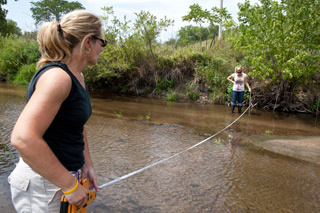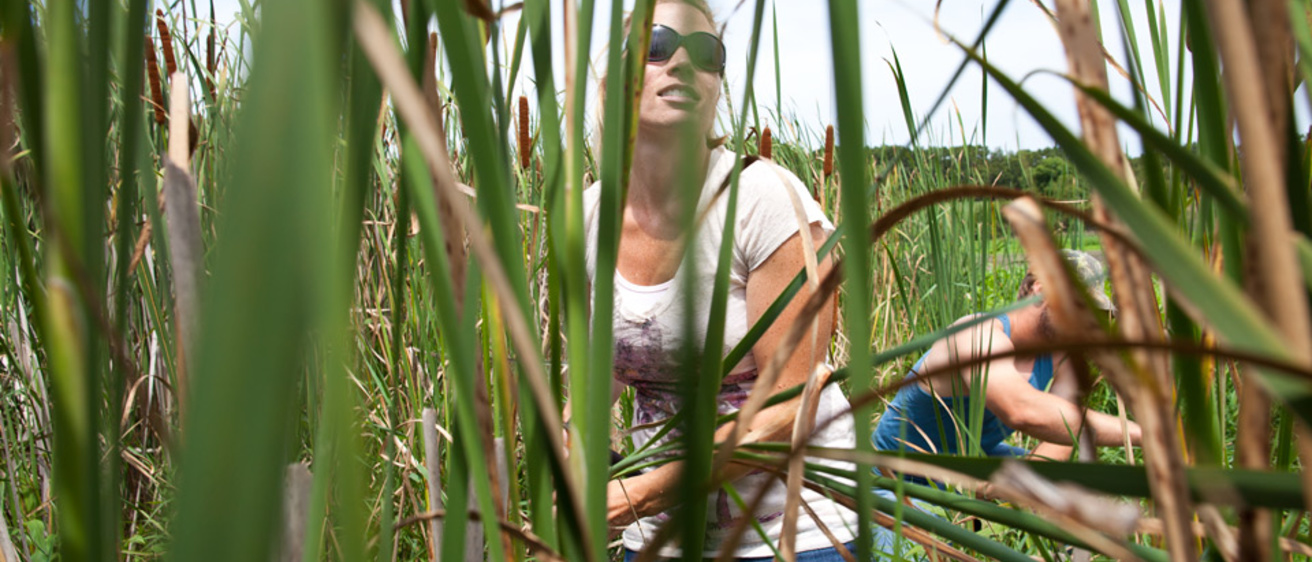On a recent sweltering morning, three teachers trudged through 6- to 7-foot-tall cattails at Wickiup Hill Learning Center in rural Toddville, working side-by-side with Meskwaki Indians from the Tama settlement, Linn County naturalists, and community volunteers.
Their mission: to clip as many of the cattails as possible, about 8 inches up from the ground, to eventually weave into matting for covering on wickiups, or winter huts used by indigenous groups for thousands of years.
“It was like walking in a very dense cornfield,” says Kathy Geers, a junior high/high school math teacher in the Alburnett Community School District.
The cattail harvest will improve the condition of a Wickiup Hill Learning Center exhibit, which is going on 10 years old. The upgrade is needed—the existing cattail mats are brittle and punctuated with holes punched out by kids—and offered a great opportunity to partner with the Meskwaki.

So what prompted Geers and two fellow educators (John Williams, a biology and environmental science teacher at Washington High School in Cedar Rapids, and Angie Alzheimer, a science teacher at the Des Moines Community School District) to cut down cattails?
They are among 56 teacher “externs” from across the state participating in the Iowa Mathematics & Science Education Partnership (IMSEP)’s Real World Externship Program for Teachers of Mathematics and Sciences.
The program’s mission, now in its fourth year, is to give math and science teachers real-world experience using science, technology, engineering, and mathematics (STEM) concepts. Beyond the cattail gathering, the three educators at Wickiup Hill participated in watershed testing, rewritten education programs, and created wetland ID cards for the macroinvertebrates in the Wickiup wetland.
Six higher education mentors—including Ted Neal and Leslie Flynn from the University of Iowa College of Education—oversee the externs. Funding comes from a National Science Foundation grant and Iowa Department of Revenue funds.
Taking knowledge back to classroom
The ultimate goal is to inspire young learners through real, local applications of math and science concepts, which the teachers bring back to school in the fall.
“A great example of this comes from our water testing. Students don't often think of where their water comes from, or what it takes to make sure the water that comes out of their faucet is clean enough to drink,” Williams says. “Through the externship experience, I've learned how we (in Cedar Rapids and Iowa City) get our water. I've learned how it is filtered, and the things that can cause health concerns and problems with the water.”
Williams adds that he’s also learned who, on a professional level, tests and monitors the water supply and the health of Iowa’s streams and rivers.
“I've also learned the education necessary for an aspiring student to enter into such a career,” Williams says. “I plan to take these experiences to the classroom, where the combination of career possibilities and the daily effects of water quality will enhance student learning and involvement.”
Most of the externs started working June 11 and continued through the end of July. Why would these teachers take time away from their summers off when they could be boating, vacationing, and spending time with family and friends?
“This is great professional development. It is so wonderful to be able to collaborate with the businesses and other teachers,” Geers says. “Learning about jobs out there that use math and science and the skills and characteristics our students need to bring to these jobs is so valuable.”
Most high school math and science teachers go directly from being students to teaching, says Neal, a clinical science instructor at the UI College of Education and externship mentor.
These experiences allow teachers to answer students’ questions when they ask, “Why do I have to learn this?” or “When will I ever use this?”
“I enjoy the whole experience,” says Geers, who is participating in the program for a second time. “Last year I worked with engineers and this year with naturalists. I love learning what they do and taking notes of what I can take back to the classroom for my students.”
Everyone wins
The program is equally valuable to businesses and state and county entities that participate.
“It’s a real win-win: this experience can build future partnerships that you might use later for either the teachers or the businesses,” says Gail Barels, conservation education specialist at the Wickiup Hill Learning Center. “Everyone gains a new perspective on either teacher or business methods. Teachers can learn the educational requirements for various jobs and therefore they can tell students why they are learning what they are being taught.”
The externs get experience in businesses ranging from Procter & Gamble and Rockwell Collins to nonprofit, governmental, or university-affiliated organizations such as the State Hygienic Lab at the UI, just to name a few.
Neal says that those participating businesses that identify a good problem for the externs to solve “get true benefits.”
Teachers, businesses, or others who wish to participate or learn more about the Real World Externships for Teachers of Mathematics, Science, and Technology can contact IMSEP Director Jeffrey Weld at 319-273-2723 or IMSEP@uni.edu or visit iowastem.gov/imsep/businesses.
The program is an inter-university partnership coordinated through the Iowa Math & Science Education Partnership, an operations arm of the Governor's STEM Advisory Council.
“Allen Hospital had a teacher extern come in a few years ago and color code their walls,” Neal says. “Basically, if a patient is on the sixth floor and needs to go to x-ray, technicians could tell patients to follow a certain color-designated line. They saved hundreds of thousands of dollars in manpower by simply building this color-coded system for patient transfer within their hospital.
“So if businesses come up with an appropriate thing it’s a really strong piece for them,” Neal continues. “They get inside a teacher’s view instead of a strictly business perspective. You bring a teacher in, and it changes the whole thing. They bring a fresh, new, different approach to tackling issues and solving problems.”
“The biggest piece is that this is building relationships with businesses and schools," Neal says. “This is opening doors to build awareness of STEM opportunities to better prepare our teachers and students for the future.”
Williams says that many teachers have never worked in any area other than education.
“Because of this fact, many of us do not have the information necessary to guide interested students toward careers in science. Through this externship experience, we are able to network with professionals in the science field and possibly match interested students with shadowing experiences in the future,” Williams says. “Also, these professionals provide an invaluable resource, as many of them would be happy to come into the classroom and explain what they do, and what it would take to get a job like theirs.”
Neal says that it’s critical that businesses make an investment in their local community schools and help develop their future employees.
“Businesses that want trained employees and don’t want to ship their jobs overseas need to become more involved with schools and curriculum,” Neal says. “Schooling needs to be like the village—it takes a village to raise a child, and businesses are a big part of the village. This externship program does that.”
